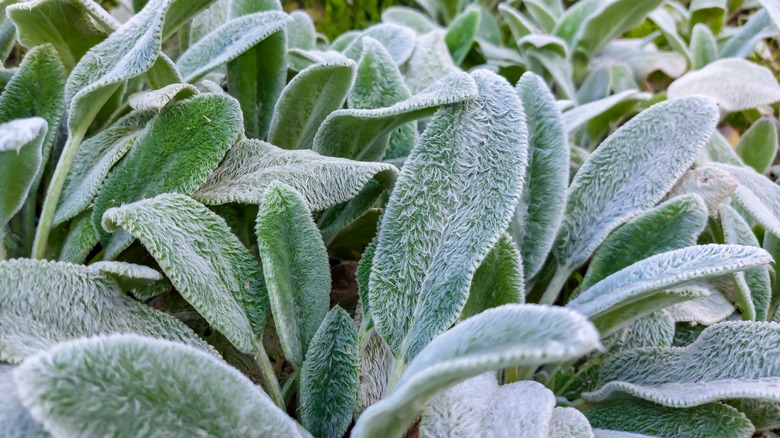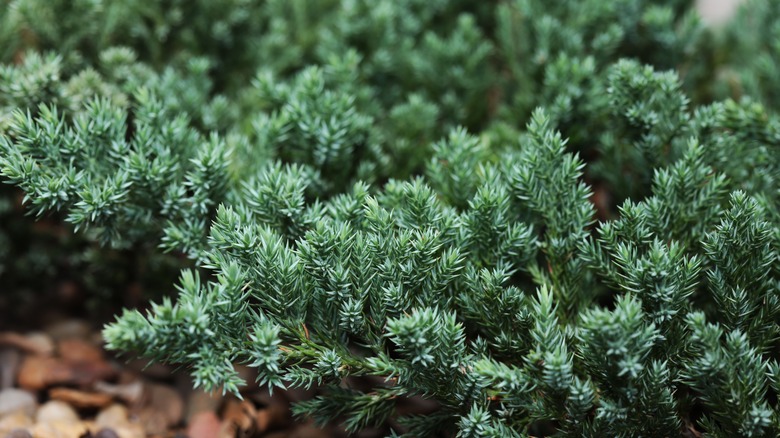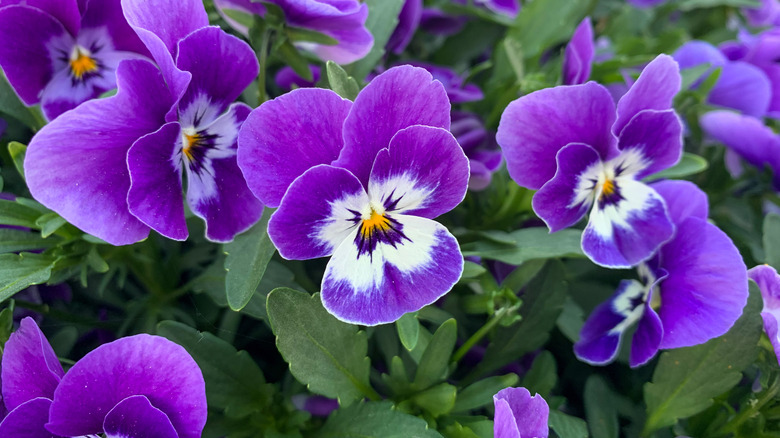15 Ground Cover Plants You Should Grow Instead Of Grass In Your Yard
There are a number of reasons replacing traditional turf grass in your yard is a good idea. The variations allow beauty and uniqueness and tend to be environmentally beneficial, often requiring less watering and energy-laden upkeep like pruning and mowing. Well-chosen groundcovers also assist in keeping your yard or neighborhood more ecologically diverse and solve common problems like erosion or drought conditions.
Alternative groundcovers are also an excellent option for grass replacement in those areas of your yard that resist grass, require erosion protection, or seem inhospitable to other greenery. According to New Garden Landscaping & Nursery, groundcovers can also be an economical choice, requiring less care and expensive replacement than traditional turf yards. Most groundcover plants are perennial, and outside of a bit of pruning to keep your variety from growing where you don't want it to, most need little upkeep. Whatever your climate, traffic patterns, aesthetics, or other needs, there is a perfect and beautiful groundcover for you. You just have to find it!
1. Lamb's ear
Lamb's ear (Stachys byzantina), a member of the mint family, is a hearty alternative if your yard gets full sun or minimal shade throughout the day. Known for its pale green and slightly fuzzy leaves, lamb's ear sprouts purplish-pink flowers each spring that rise 10 to 15 inches above the leaves. According to The North Carolina Extension Plant Toolbox, lamb's ear plants require well-draining soil, do well in most soil types, and thrive in USDA zones 4 through 8. This plant blooms in summer and grows 12 to 18 inches tall and up to 12 inches wide.
2. Japanese pachysandra
Japanese pachysandra (Pachysandra terminalis) is an excellent choice for shady areas in your yard that get little to no sun. This groundcover sports low, broad plants and tiny white buds in the spring and summer. Deer and rabbit resistant, Japanese pachysandra does best in USDA zones 4 through 8 and moist but well-drained soil conditions. According to The Morton Arboretum, Japanese pachysandra originated in Japan and grows heartily in several climates but is considered an exotic invasive species in some states. Plants grow about 6 to 12 inches high and up to 12 inches wide.
3. Goldmoss stonecrop
If the conditions of your yard are dry for most of the year, an excellent alternative to grass may be goldmoss stonecrop (Sedum acre). According to Plant Care Today, this evergreen succulent thrives best in USDA zones 3 to 8 and benefits from full to partial sun. This species, which only grows to a height of 3 inches and 24 inches wide, is often found in a number of soil conditions, including the dry, rocky terrain of ravines and crevices. This variety sprouts yellow star-shaped flowers each spring and summer.
4. Delosperma
Delosperma (Delosperma cooperi) thrives in many settings and zones and is considered a variety of ice plants. According to High Country Gardens, the species does particularly well in the dryer, less humid USDA zones 6 through 8 (the Appalachian mountains and Eastern Seaboard), where it is a perennial. Growing up to 6 inches tall and 24 inches wide, the most common variety of Delosperma boasts pink and yellow flowers each spring but can come in various shades, including red, orange, and violet. Delosperma does best in rocky, sandy, or loamy soils but is not as friendly to clay-based varieties.
5. Creeping dogwood
If you're looking for the perfect groundcover for shady areas under and around trees, Creeping dogwood (Cornus canadensis) is a perfect choice. This species thrives in shady areas, where other plants often fail. According to Fine Gardening, this unassuming plant features small white buds each spring and can grow 6 to 12 inches tall and 12 inches wide. In moist, acidic soil conditions, creeping dogwood does best in USDA zones 2 through 7. These plants can grow several yards wide and often have small, scarlet berries after blooming.
6. Lilyturf
This creeping groundcover with spindly leaves is perfect for various climates, particularly in small spaces between paver stones or narrow strips of land. A durable option that needs only moderate water and thrives in partial shade and partial sun environments, Lilyturf (Liriope muscari) does best in USDA zones 4 through 10. Lilyturf blooms in late summer with purple, tall blossoms. According to Monrovia, many homeowners appreciate the resemblance of Lilyturf to traditional grass. Plants can grow from 10 to 16 inches tall and up to 18 inches wide. Lilyturf thrives best in sandy or clay soil with good drainage.
7. Blue star creeper
Blue star creeper (Isotoma fluviatilis) is a perfect option for high foot traffic areas of your lawn where you might otherwise use traditional turf. These low-rise, 2 to 3-inch tall plants grow up to 18 inches wide and are crush-proof and durable in most soil types and conditions, including full sun or partial shade. Deer and rabbit resistant, blue star creeper is named for its star-shaped pale blue flowers that bloom each summer, forming a blanket of beautiful blossoms. According to Great Garden Plants, they thrive best in USDA zones 6 through 9.
8. Creeping juniper
Hills and sloped areas in your yard can often be the most challenging areas to cover, and drainage issues and erosion can plague even the most careful plantings. Creeping juniper (Juniperus horizontalis) forms a rich, dense cover perfect for these more dangerous areas. Growing anywhere from 6 to 12 inches tall and forming a mat up to 10 feet wide, creeping juniper does well in several climates and soil and adapts well to harsher environments, according to Epic Gardening. Creeping juniper does best in USDA zones 3 through 10.
9. Dwarf carpet of stars
We love our pets, but they can wreak havoc on even the heartiest traditional lawns. Dwarf Carpet of Stars (Ruschia 'Nana') is a great alternative, forming a mat of durable, resistant plantings that can stand up to your pooch. According to Gardening Brain, this plant grows to about up to 2 inches high and spreads up to 3 feet wide, sprouting small pink flowers in the spring and fall. Dwarf Carpet of Stars is happy in several climates and soil conditions and thrives best in USDA zones 9 through 11. Ruschia 'Nana' prefers full sun.
10. Creeping phlox
With a dense thicket of roots below ground, creeping phlox (Phlox stolonifera) offers an excellent solution to erosion problems in your yard. While the plants can thrive in any soil, according to Great Garden Plants, creeping phlox is particularly perfect for rocky and sandy soils rich with organic matter. Phlox stolonifera does well in USDA zones 3 through 10 in various sun circumstances and blooms in spring. While purple-pink flowers are most common, you can purchase seeds for different-colored blooms, including blue and red. Creeping Phlox grows up to 8 inches tall and 2 feet wide.
11. Chamomile
While usually found at the bottom of a teacup, this durable chamomile (Matricaria chamomilla), comes in several varieties, most averaging 3 to 6 inches tall and up to 12 inches wide, according to Victoriana Nursery Gardens. Once the chosen ground cover for many English manors, today's varieties can thrive in several conditions but appreciate full sun best. Matricaria chamomilla requires some upkeep and blooms in spring and summer. While they do not do well with heavy traffic, stepping on them releases a delicious scent that makes them more than worth the care needed to help them grow. Chamomile thrives best in USDA zones 3 through 9.
12. Horned violets
While many groundcovers sport blossoms during certain parts of the year, some are more beautiful and showy than others. Horned violets (Viola cornuta), members of the pansy family, come in an array of shades varying from deep purple to pale lavender — and even red! A perennial in more moderate climates, these low plants with gorgeous blooms are perfect in conditions of average moisture and partial shade in USDA zones 5 through 9. According to Plants For A Future, these blooms every spring and summer and can grow up to 8 inches tall and 12 inches wide.
13. White clover
White clover (Trifolium) is an excellent option for a low-maintenance lawn. White clover grows naturally in any environment and withstands drought and damp conditions. While some consider it an invasive species in the U.S., this European transplant also survives quite well in several climate and soil varieties, including sandy or rocky earth. It requires less watering and chemicals than traditional grass and is an excellent source of nitrogen in the soil, according to the University of Georgia Extension. White clover blooms in spring and does best in USDA zones 4 through 9; plants measure up to 8 inches tall and 18 inches wide.
14. Moss
Moss (Bryophyta) is probably already blooming somewhere in your yard, and with a little help, according to the Clackamas Soil and Water Conservation District, you can use it as a soft and lush groundcover. While not durable for heavy traffic, moss is perfect in untrod areas and spaces between paving stones. It is also excellent for shady areas under trees, garden statuary, and near your home's foundation. It grows best in USDA zones 4 through 8 in acidic, alkaline, or neutral soils. Depending on the variety, moss usually measures 1 to 2 inches tall and up to 12 inches wide.
15. Oregano
Like Chamomile, oregano (Origanum vulgare) is a deliciously scented addition to any yard, according to Dave's Garden. Oregano comes in several varieties, with plants measuring 6 to 24 inches and up to 24 inches wide. As a groundcover, oregano thrives best in warm climates with rocky or sandy soil — thus its popularity in Mediterranean cuisine, where it grows quite readily. It exudes the scent of the best Italian and Greek meals when trod upon and is easily harvested for your kitchen. It grows best in USDA zones 4 through 10 in well-drained soil and blooms in summer.















